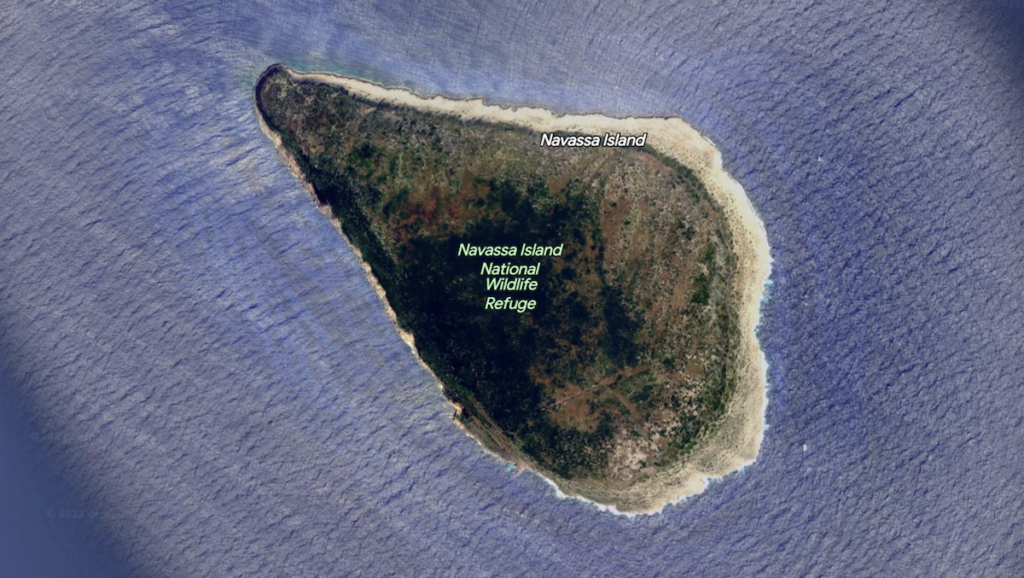The United States of America is a misleading name because there are more than just states. You undoubtedly know that Washington D.C. is not a state, and most of you likely know that Puerto Rico is a U.S. territory but not a state (side note: taxation without representation is tyranny).
Fewer probably know about the U.S. Virgin Islands, fewer still about Guam, then maybe American Samoa, and by the time we get to the Northern Mariana Islands, we’re talking to a pretty small percentage of people.
All of those places are known as U.S. Overseas Territories. But if you think this country – one built on the backs of conquest and manifest destiny – has no weirder, less clearcut territories under its umbrella, think again. Think again, but this time about Navassa Island.
I would bet good money that you’ve never heard of Navassa Island before just now. It’s a 2.1 square mile island about 40 miles west of Haiti; it’s also northeast of Jamaica and south of Cuba. You might describe its location as being plopped right in the middle of a bunch of other Caribbean islands.
Back in 1504, Christopher Columbus (who you may have heard of) was stuck in Jamaica, so he sent some of his guys out into the sea for help. They landed on what is now Navassa, but since it had no water, they left. Nobody bothered with the island for centuries thereafter.
How Guano Led to Murder on Navassa Island
Haiti believes it has had a right to Navassa since 1801, at which point the nation claimed a bunch of islands close to mainland Haiti by name. Haiti did not name Navassa (or the French equivalent since that’s their native language). They did also claim “other adjacent islands” but that was open for dispute. When Haiti rewrote its constitution in 1874, they explicitly named Navassa, also noting they had been claiming it since 1801.
The USA disagreed. In 1857, an American sea captain named Peter Duncan claimed the island for the USA under the Guano Islands Act of 1856, an honest-to-God federal law that enabled citizens to claim unclaimed islands for the U.S. if there was a good amount of mineable bird shit. Haiti protested, but when a sitting U.S. president says, “We’re prepared to use military force to protect this claim,” there’s not a lot you can do as an island nation.
To strengthen this point, in what was surely an extremely fair and not-at-all suspicious trial, Jones v. United States was an 1890 Supreme Court decision that found Navassa Island must be considered part of the U.S., setting a legal precedent for ownership of the island. Though the trial was not about the island itself; rather, it was about whether a murder that took place on the island could be tried as if it were U.S. territory.
Why was there a murder on this more or less uninhabited island? I’m glad you asked.
The Navassa Island Rebellion of 1899
Guano mining was a booming business – literally in the sense that sometimes dynamite was used to dislodge the poo, and figuratively in the sense that over one million pounds of guano was mined from this tiny island between 1865 and 1898. According to the Baltimore City Paper, the Navassa Phosphate Company of Baltimore built mining facilities and contracted with 140 black laborers from Maryland, plus white supervisors. A small town was built for these people.
As you might expect, Caribbean heat paired with backbreaking labor is hard on the mind and body. In 1899, a rebellion happened. With the workers vastly outnumbering the supervisors, the latter faced a math problem in the fight. Five supervisors were killed and a U.S. warship ultimately returned 18 of the workers to Baltimore on murder charges.
Back to Jones v. United States: The trial ultimately ruled that the Guano Act was constitutional, which made Navassa a U.S. territory, which made this American soil, which made this a punishable offense. Three of the workers were sentenced to execution.
Thankfully, President Harrison commuted the sentences to imprisonment, and that was the last vestige of the murder and its subsequent trial. As for the island itself, Navassa was uninhabitable by 1899 due to the Spanish-American War making it nearly impossible to safely access the island. The mining company went bankrupt, and the island was sold at auction, though a dispute over the sale managed to leave four contract workers abandoned on the island for about six months. Really smart planning by all those involved.
In the present, Navassa Island is now the Navassa Island National Wildlife Refuge, part of the greater Caribbean Islands National Wildlife Refuge complex. It is not accessible to the public.
On the bright side, by being inaccessible, the raw number of murders has dropped to zero.
